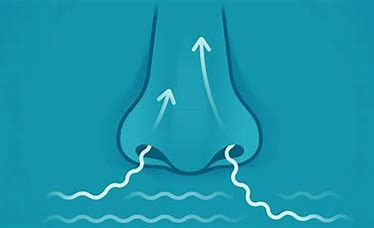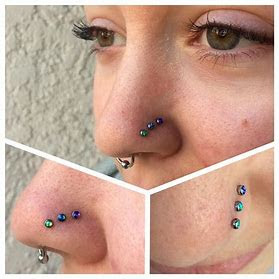- Get link
- X
- Other Apps
The nose is a complex organ located on the front of the face between the eyes. In addition to its physiological functions, the nose can also have cultural, aesthetic, and medical significance. It is a prominent facial feature that contributes to a person's overall appearance, and it can play a role in personal identity and expression. Various medical conditions, such as allergies, sinus infections, and deviated septum, can affect the function and health of the nose.
Anatomy and Structure
- Nostrils (Nares):
- These are the external openings of the nose through which air enters.
- They are separated by a thin partition called the nasal septum.
- Nasal Septum:
- This is a wall made of bone and cartilage that divides the nasal cavity into two separate passages.
- It extends from the nostrils to the back of the throat.
- Nasal Cavity:
- The nasal cavity is a hollow space within the nose that extends from the nostrils to the back of the throat.
- It is divided by the nasal septum into two sides.
- The walls of the nasal cavity are covered with mucous
membranes that contain blood vessels and mucus-producing cells.
- Sinuses:
- These are air-filled spaces located within the bones of the skull and face.
- The sinuses help lighten the skull and are connected to the nasal cavity through small openings.
- They also play a role in humidifying and warming the air we breathe.
- There are four pairs of sinuses: frontal, ethmoid, sphenoid, and maxillary.
- These hollow spaces within the skull are lined with mucous membranes and are connected to the nasal cavity.
- Sinuses contribute to
the overall resonance of the voice, and they can sometimes be prone to
infections.
- Nasal Turbinate (Conchae):
- These are three pairs of scroll-like bony structures inside the nasal cavity covered with mucous membranes.
- They help increase the
surface area of the nasal passages, aiding in air filtration, humidification,
and temperature regulation.
- Olfactory Bulb and Olfactory Nerves:
- This is a part of the brain located above the nasal cavity and is involved in processing and interpreting olfactory information from the olfactory receptors in the nasal epithelium.
- The olfactory nerve carries these signals to the brain, allowing us to perceive smells.
- Nasal Cartilage:
- The external structure of the nose is made up of cartilage, which gives the nose its shape and structure.
- Nasal Vestibule:
- This is the front part of the nasal cavity, just inside the nostrils.
- It contains coarse hairs that help filter out larger particles
from the air.
Function
- Olfaction (Smell Sensation):
- The primary function of the nose is to detect odors and when these molecules meet the receptors, they generate nerve impulses that the brain interprets as various smell and send signals to the brain about the scents in the environment.
- Inside the nasal cavity, there is a specialized area
called the olfactory epithelium, which contains olfactory receptors responsible
for detecting different odorous molecules.
- Respiration (Breathing):
- The nose plays a crucial role in the respiratory system by filtering, humidifying, and warming the air we breathe before it enters the lungs.
- The nasal passages are lined with mucous membranes that help trap dust, debris, and potentially harmful particles from the air.
- Sense of Taste:
- The sense of taste and smell are closely linked.
- The perception of flavor is a combination of taste and smell. When we chew food, aroma molecules are released, and they travel through the back of the mouth to the olfactory receptors, contributing to the overall flavor experience.
- Speech and Vocalization:
- The nose contributes to the resonance and quality of the voice.
- Changes in the shape and structure of the nasal passages can affect the sound of one's voice.
Environmental and Adaptive Functions
- Cold Weather Adaption:
- The turbinate in the nasal cavity plays a role in adjusting the temperature of the air we breathe.
- In cold weather, the turbinate help warm up the incoming air before it reaches the lungs.
- Smelling Danger:
- The sense of smell can be an important survival tool.
- Humans can sometimes detect certain dangers, such as gas leaks or spoiled food, through their sense of smell.
- Medical Aspects
- Nasal Congestion:
- Swelling of the blood vessels in the nasal passages can lead to congestion, making it difficult to breathe through the nose.
- This is often caused by allergies, infections, or irritants.
- Rhinitis:
- Inflammation of the nasal mucous membranes can result in symptoms like a runny or stuffy nose, sneezing, and itching.
- Allergic rhinitis is a common form triggered by allergens.
- Sinusitis:
- Inflammation or infection of the sinuses can lead to
sinusitis, causing symptoms such as facial pain, pressure, and nasal
congestion.
- Deviated Septum:
- When the nasal septum is off-center, it can obstruct airflow and lead to breathing difficulties.
- Nasal Polyps:
- These are growths that develop within the nasal passages or sinuses and can cause congestion and other breathing issues.
- Anosmia and Parosmia:
- Anosmia refers to the complete loss of the sense of smell, while parosmia is a condition where smells are perceived differently from their actual source.
- Both conditions can have various causes, including
viral infections, head injuries, or neurological disorders.
- Smell Disorders:
- Conditions like anosmia (loss of smell) or hyposmia
(reduced ability to smell) can result from various factors, including
infections, head injuries, or neurological issues.
Aesthetic Considerations
- Rhinoplasty:
- Rhinoplasty is a surgical procedure that aims to modify the shape or structure of the nose for cosmetic or functional reasons.
- It's one of the most common cosmetic surgeries and can be used to address breathing difficulties or to enhance facial harmony.
- Body Dysmorphic Disorder (BDD):
- Some individuals may develop an obsessive focus on their perceived flaws, which can include the appearance of their nose.
- This condition is known as body dysmorphic disorder.
Cultural and Social Significance
- Personal Identity:
- The shape and size of the nose can vary significantly among individuals and are often an integral part of a person's facial identity.
- Cultural Symbols:
- In different cultures, the nose can hold symbolic meanings.
- For example, in some societies, the shape of the nose might be
associated with certain traits or characteristics.
Animal Noses
- Variations in Animal Noses:
- Noses come in many shapes and sizes across the animal kingdom, and they serve diverse functions beyond smell.
- For example, elephants
use their trunks for grasping and smelling, while dogs use their highly
sensitive noses for tracking scents and detecting illnesses.
- Moisture Regulation:
- Some animals, like dogs, have a specialized structure called the Jacobson's organ (or vomeronasal organ) that allows them to detect pheromones and chemical cues related to mating and territory marking.












Comments
Post a Comment